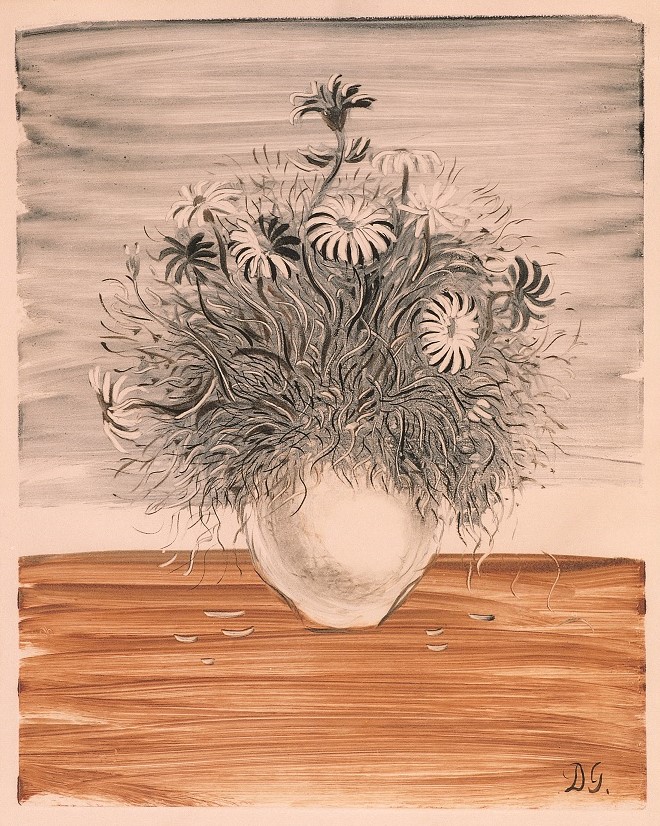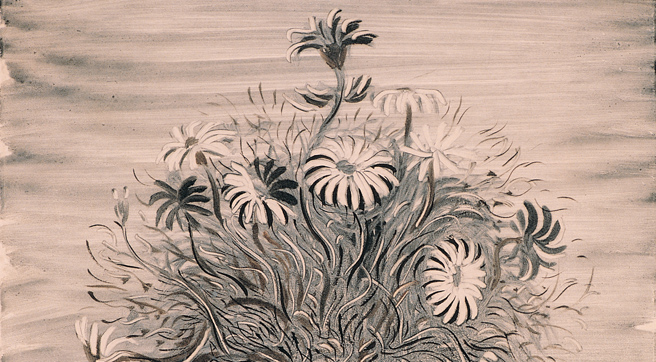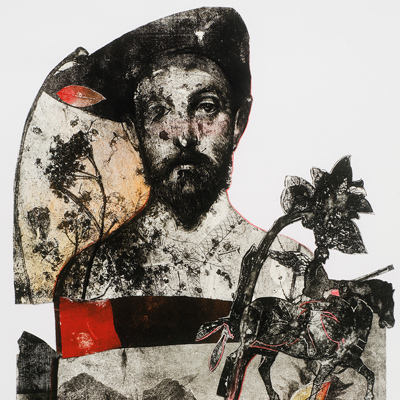Dimitris Galanis, Les Marguerites
The floral print Les Marguerites (The Daisies) by Dimitris Galanis is a rare monoprint, meaning that only 1 impression has been printed. Galanis lived in France and worked with various engraving techniques. This is a particularly challenging technique, as it combines engraving and painting. Many of Galanis’ prints are featured in various publications.
A unique floral print
The piece Les Marguerites (The Daisies) by Dimitris Galanis depicts a vase with daisies on a neutral, grey background.
The decorative elements of the flowers, such as the leaves, stems and blossoms, create a pleasing, smart and light end result.
To achieve this, Galanis approached this floral painting from a unique artistic angle:
- He isolated the decorative elements.
- He simplified their shape.
- He harmonised them, so that the piece would meet the specifications of a print.
The floral theme is showcased through the alternating use of the vivid warm brown and cold grey hues.
The rare technique of the monoprint
This print was created using the monoprint technique. It is a unique and rare technique combining painting and engraving. The final piece is unique, in contrast to engraving where multiple identical prints are produced. Monoprints often feature painting or other interventions by the artist.
His life in a nutshell
Dimitris Galanis (1879-1966) was born in Athens. From 1897 to 1899 he studied at the School of Civil Engineering, National Technical University of Athens. There he also attended drawing classes under the great painter and teacher Nikiforos Lytras.
In 1900 he moved to Paris where he studied at the École des Beaux-Arts on scholarship.
Until 1912 he published satirical drawings in different French magazines (Le Rire, Assiette au Beurre, Frou-Frou).
His interest in engraving had started to unfold as early as 1907-1909. It was then that he originally started working with woodcuts.
Between 1930 and 1937 he taught engraving to Greek artists studying in Paris, such as Nikos Hadjikyriakos-Ghikas, at his workshop.
Artistic influences
His stay in Paris had a decisive impact on the artist. There he had the opportunity to follow artistic developments and eclectically adopt some of them, such as Cubism.
He found himself in the same circles as great painters of the time, including Pablo Picasso, Henri Matisse, Georges Braque and André Derain.
Favourite themes
Galanis mostly worked with still life. He later turned to landscapes, nudes and mythological themes.
When he focused his professional activities to book and album illustrations, he ventured into many more thematic areas.
Artistic style
Dimitris Galanis is considered one of the first European engravers to create cubist prints. His work stands out for the quality and unique character of his linear representations.
During the 30s, together with other artists, he revisited a more academic, descriptive and detailed artistic style. In this manner, he clearly adapted his personal style to more classical themes.
A recognised artist
Galanis presented his work in solo exhibitions and also participated in group exhibitions in Paris, in major European and US centres, and in Egypt.
His first exhibition in 1928 at Iliou Melathron in Athens essentially introduced the art of engraving to the public. His works became a point of reference at least for the next 20 years.
In 1945 he was appointed professor of Engraving at the École des Beaux-Arts in Paris and became a member of the Académie Française. In 1949 he became a member of the Academy of Athens.
The founder of engraving
Galanis is considered an important teacher and the undeniable founder of engraving in Greece. He influenced the younger generations of Greek engravers more than anyone. For many decades, in works of different artists, it is possible to detect elements and influences from Galanis’ work.
But his most important gift to engraving was giving it its independence. The decade 1925-1935 was the period when engraving became truly autonomous.
Owing to the great appeal of his work, in 1932 the chair of Engraving was reinstated at the Athens School of Fine Arts, after being eliminated in 1914.
Galanis in the Alpha Bank Art Collection
The Alpha Bank Art Collection features a large number of books illustrated by Dimitris Galanis, including Ophelia, by G.S. Spyridakis. For these books, Galanis created:
- Cover pages.
- Small decorative designs, the so-called vignettes.
- Historiated initials and frontispieces.
The Alpha Bank Library includes The Comedies, Histories and Tragedies of Shakespeare in its collection of rare publications. The book is illustrated by the same artist.
The work of art in our publications
The piece Les Marguerites (The Daisies) by Dimitris Galanis is referenced in the Alpha Bank publications:
- The Alpha Bank Collection. Paintings – Prints – Sculptures, edited by Irene Orati. The publication marks the 125th anniversary of Alpha Bank.
Buy the publication The Alpha Bank Collection. Paintings – Prints – Sculptures on the Alpha Bank e-shop (only available in Greek). - The Alpha Bank Collection. Greek Art from 1920 until Today, edited by Irene Orati. The publication accompanied the Art Collection’s exhibition at the Macedonian Museum of Contemporary Art in Thessaloniki.
Buy the publication The Alpha Bank Collection. Greek Art from 1920 until Today on the Alpha Bank e-shop. - Affinities: Flowers in Greek Art, edited by Irene Orati and Eleni Kypraiou. The publication accompanied the same-titled exhibition presented at Nafplion at the Alpha Bank Cultural Centre and the Annex of the National Gallery.
The Alpha Bank Art Collection is not open to the public.
Research visits to the Art Collection can be organised upon request.
Contact us to book your visit.







